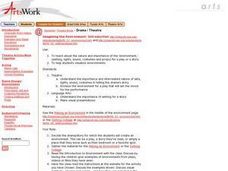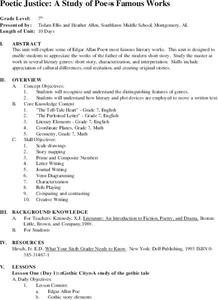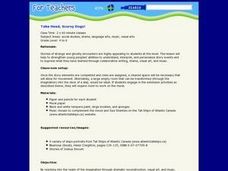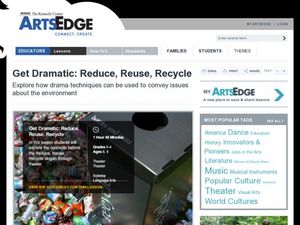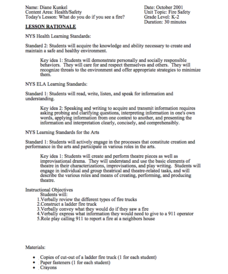Curated OER
Imagining the Environment: Introduction
Students examine the importance of the environment including the setting, lights, sound, costumes, and props for a play or story. They visualize the appropriate environments and practice applying the techniques.
Star Wars in the Classroom
"Shakespeare and Star Wars": Lesson Plan Days 13 and 14
How important are sound effects in films? In stage plays? In radio programs? To gain an understanding of the impact of these special effects, class members watch a short video spoof of the sound in a scene from Star Wars: A New...
Curated OER
Hoe Down: An Integrated Unit on Social, Folk & Square Dancing
Fifth graders experience the movements required to perform social, folk and square dancing. They describe each dance movement. Students discuss the elements found in folk art, folk music, and fold dance.
Curated OER
Poetic Justice: A Study of Poe's Famous Works
Students explore Edgar Allan Poe's most famous short stories. In this Edgar Allan Poe lesson, students complete a 25 page packet of activities where they recognize the features of genres and literary devices Poe uses. Students read "The...
Curated OER
Technology Rich Native American Unit
Student groups retell stories from Iroquois storytellers. They role-play Iroquois women, men and children and explain their roles. They read "Knots on a Counting Rope" and make up their own stories. They create timelines. They visit a...
Curated OER
Conflict Resolution
Second graders discuss conflict resolution. In this conflict resolution lesson, 2nd graders look at conflict scenarios and act them out in front of the class showing how they would handle the situation. They write on a piece of paper 3...
Curated OER
Street People
Students research homelessness including how people end up living on the streets and other related issues such as government response and charity. Using their research, students engage in improvisation, role-plays and monologues on the...
Curated OER
Take Heed, Scurvy Dogs!
Pupils examine the use of ghosts in shipping stories. As a class, they assign roles and they act them out in a play. They make it seem as if they are in danger on their voyage and work together to create a script. They ask questions...
Carnegie Library
Creative Writing: Middle School Lesson Plan
Enhance a unit on historical fiction with an engaging writing lesson. Learners bring the Industrial Era to life as they compose their own historical fiction pieces based on primary source images of Pittsburgh steel workers.
Curated OER
Being in the Noh: An Introduction to Japanese Noh Plays
Students read a Japanese Noh play and discuss its structure and traditional characters. They choose a short myth and write a Noh play based on it.
Curated OER
Clown or Comedian
Pupils discover how to compare and contrast the differences between a clown and a comedian. They use dictionaries to expand their vocabulary.
Teach With Movies
The Glenn Miller Story (Film) - Teacher's Guide
Anthony Mann's 1953 film biography, The Glenn Miller Story, is the focus of a series of activities that introduce class members to Miller's life and music. Of particular interest to music students will be the cameos by many famous...
Curated OER
Get Dramatic: Reduce, Reuse, Recycle
Students explain reducing, recycling and reusing. In this science/ arts instructional activity, students create a commercial and display a backdrop made out of recycled goods. Additionally, students write written responses to writing...
Curated OER
Canadian Olympic Fashion
Pupils, in groups, research a Canadian Olympic sport and design a uniform for a Canadian Olympic team.
Curated OER
Being in the Noh: An Introduction to Japanese Noh Plays
Students analyze the conventions used in Noh plays and write an introduction to a Noh play of their own. In this Noh play lesson, students identify the conventions of the Noh form and analyze the realizations the main character achieves....
Curated OER
Now You're Speaking My Language; Deciphering the Symbols of Early Civilizations
Young scholars explore early attempts at written language. In this early civilizations lesson plan, students investigate first attempts at written communication. Among the civilizations covered are Mayan, Greek, and Egyptian.
Curated OER
What do You do if You See a Fire?
Pupils discuss what they would do if they saw a neighbor's house on fire and what information they would need to know to tell the 911 operator. They watch as the teacher models how to call 911 and observe that the numbers are called only...
Curated OER
Movement Adventure
Students discover movement and pantomime techniques in this adventurous story telling experience for kindergarten. Assessment is done through a short question and answer session and students drawing the "adventure".
Curated OER
Family Traditions
Students research their family traditions. They select a tradition that has meaning to them and write about the traditions. They retell the story to a partner and add details. They write a draft of their story to a partner and...
Curated OER
More Than Mock Elections
Students create a presidential campaign story. In this presidential campaign lesson, students produce, direct and act in their own campaign story. Stories focus on setting, characters, context, critical incidents, and concluding events.
Curated OER
Coyote and Anansi
Students explore the structure of folktales. In this coyote and Anansi lesson, students discuss the attributes of folktales as they read versions of tales featuring coyote and Anansi. Students collaborate to write and perform their own...
Curated OER
Japanese Noh Masks
Students examine Japanese theatre and create their own face masks which display certain emotions, props, costumes and perform in improvisational theatrical games.
Curated OER
The Journey of Sacagawea
Students examine the life of Sacagawea, the exceptional woman chosen to appear on the Golden Dollar, and write journal entries based on their research.
Curated OER
Using Scholastic News to Introduce the Net
Third graders log on to the net, type in the address for Scholastic and browse the subjects for the week. They select one area of interest and generate five interesting facts about the article.


